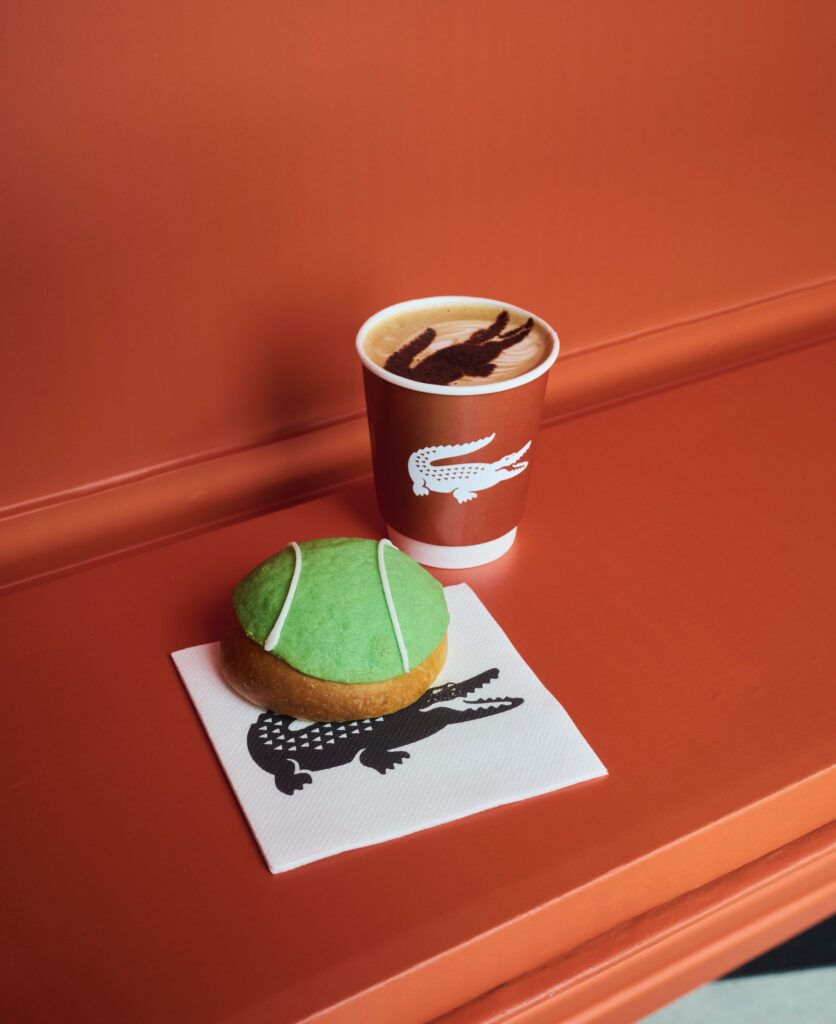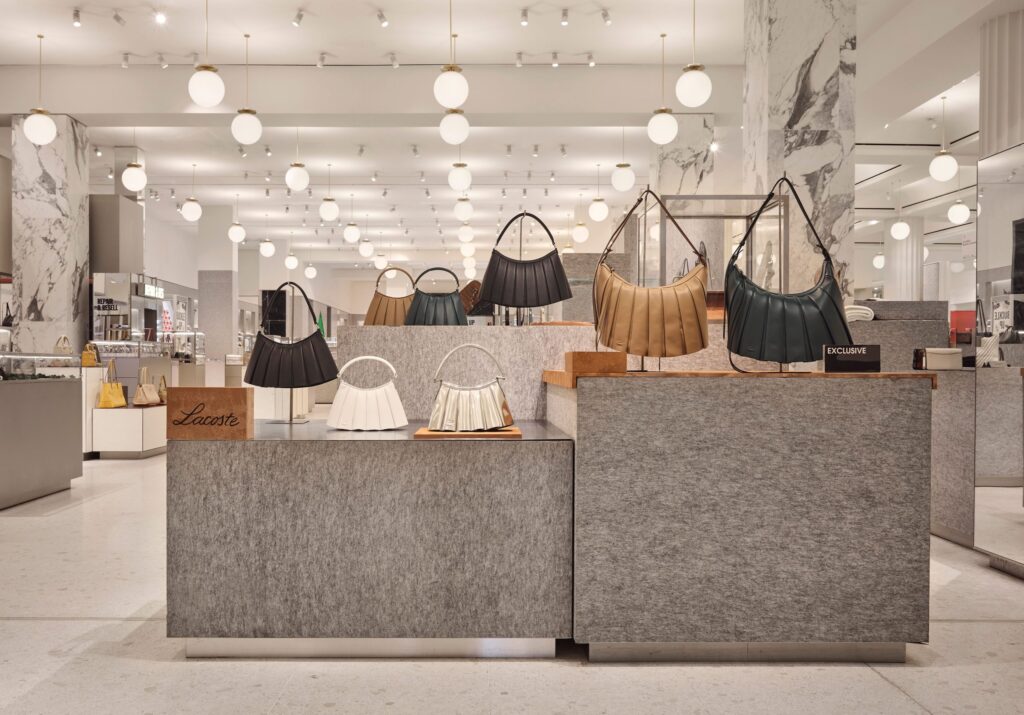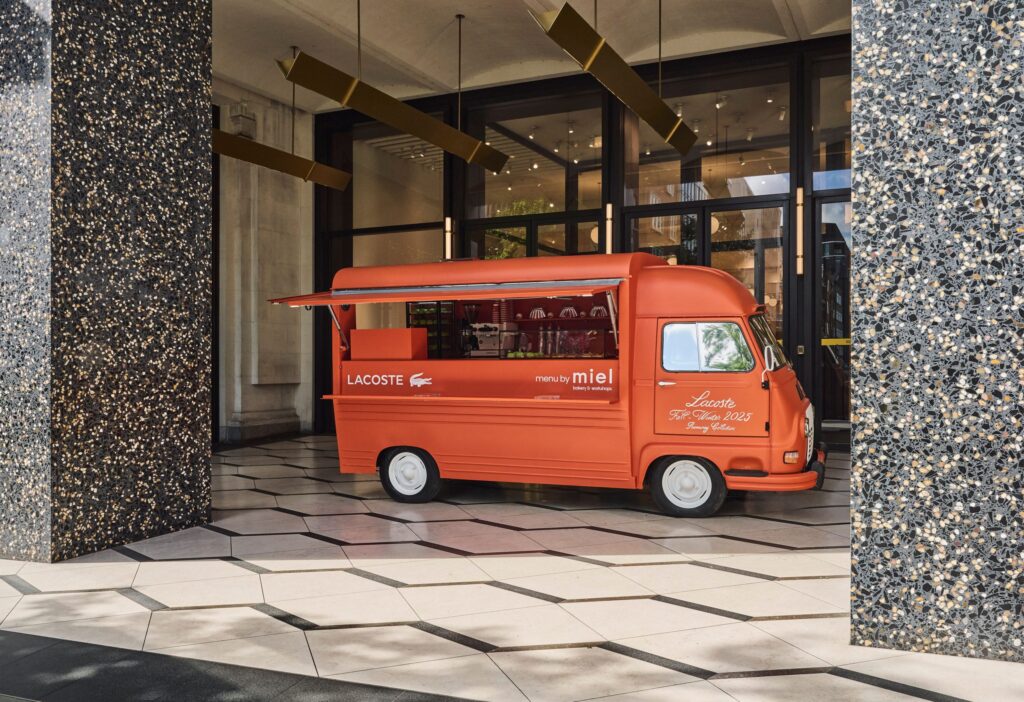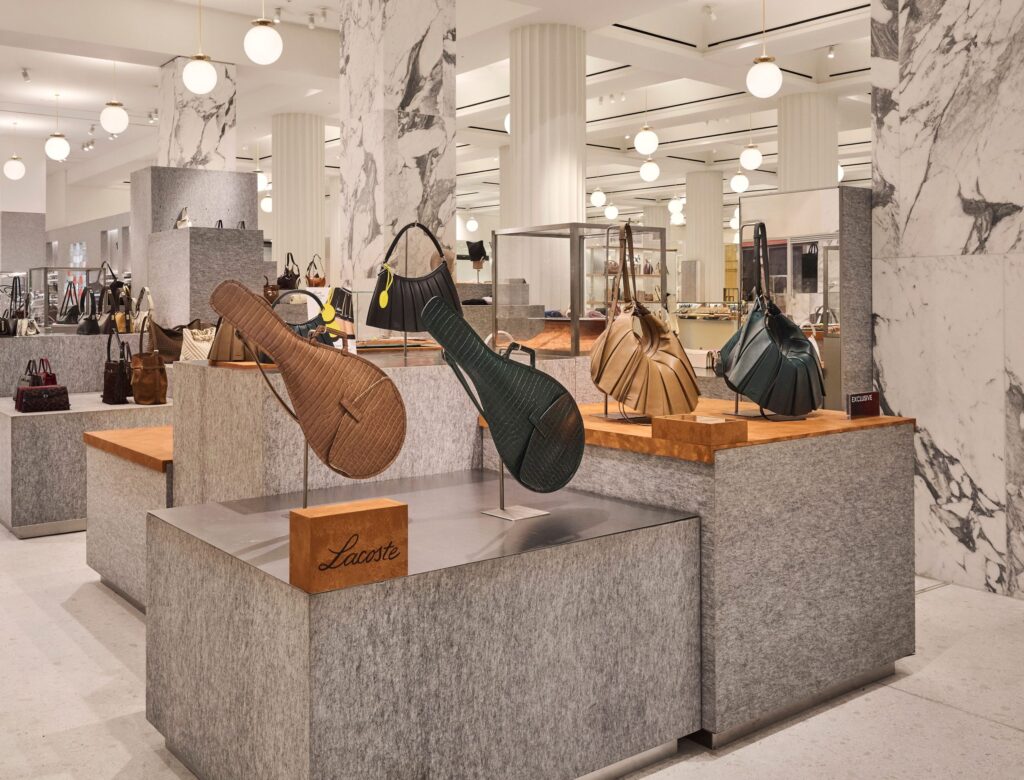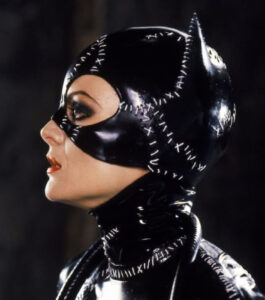For one week only, London’s Selfridges on Duke Street becomes the unlikely home of a tennis court with a gourmand twist. Lacoste, the French heritage label inseparably linked with tennis culture and understated sportswear chic, has unveiled Le Lacoste Serve Café, a clay-court-inspired pop-up that marries design, food, and fashion into an immersive brand experience. With its tennis-ball pastries and pistachio-laden brioche in partnership with bakery Miel, alongside a dedicated accessories showcase featuring the Lenglen bag and an exclusive Lenglen Hobo debut, this installation is more than a café. It is a cultural statement—one that reveals Lacoste’s ambitions to extend its presence far beyond apparel, into lifestyle territory where leisure, taste, and sport intermingle.
From René’s Racquet to Cultural Canvas
To appreciate this café’s significance, one must revisit Lacoste’s origins. Founded in 1933 by René Lacoste—nicknamed “the Crocodile” for his tenacity on the court—the brand transformed tennis attire. The crisp piqué polo shirt replaced stiff whites, introducing comfort and elegance into sportswear. That single innovation propelled Lacoste into mainstream fashion, while its crocodile logo became a universally recognized emblem of refinement tinged with sporting irreverence.
Through the decades, Lacoste has never abandoned its tennis roots. From sponsorships at Roland-Garros to merges with Novak Djokovic, the brand’s DNA is woven into the language of clay courts, baseline rallies, and the summer glamour of Wimbledon. Le Lacoste Serve Café thus represents more than clever marketing: it is a physical continuation of René’s spirit of reinvention, this time in the culinary sphere. The choice of Selfridges—arguably London’s most theatrical department store—underscores the alignment between tradition and innovation, commerce and culture.
A Café Inspired by Clay Courts
The pop-up, located under the Duke Street Canopy, has been conceived as a clay-toned tableau. The floor mimics the terracotta hue of Roland-Garros, while accents—menu cards, tableware, and decorative motifs—borrow from tennis iconography. This is not mere pastiche but a carefully choreographed mise-en-scène that transforms coffee breaks into a cultural experience.
The partnership with bakery Miel adds depth to the performance. Known for its elevated approach to viennoiserie and modern patisserie, Miel has created coltish desserts for the café. Tennis ball-shaped brioches filled with pistachio cream blur the line between sport and gastronomy. Other pastries riff on racket strings, match scoreboards, and tournament rituals, proving that design need not be confined to clothes or accessories—it can inhabit edible art.
The café’s menu does not attempt to compete with full-service restaurants but instead offers indulgent light bites and specialty coffees tailored to Instagram-driven experiences. Patrons are invited not only to consume but to photograph, post, and share, embedding Lacoste further into the digital zeitgeist. In today’s culture economy, a tennis ball pastry is both a dessert and a shareable content unit, multiplying its impact through virtual reach.
The Retail Dimension: Lenglen Reimagined
Adjacent to the café is the Accessories Hall pop-up, an installation that grounds Lacoste’s foray into lifestyle with tangible luxury product. Here, the focus falls on the Lenglen bag, named after Suzanne Lenglen, the French tennis star of the 1920s whose flamboyance and athletic dominance paved the way for René Lacoste’s era. The bag’s revival speaks to Lacoste’s archival storytelling: heritage is not static but a resource to be constantly reinterpreted.
The star of the show is the Lenglen Hobo, a global exclusive premiering at Selfridges. Crafted in supple nappa leather and suede, the Hobo features chain detailing and T-bars shaped like tennis racquet handles. This fusion of sport and elegance captures Lacoste’s dual identity—functional yet refined, playful yet luxurious. It is a piece designed not just for the court but for the street, the café, the gallery opening, or the urban commute.
The strategy here is clear: Le Lacoste Serve is not only about pastries and coffee but about positioning accessories as the cornerstone of Lacoste’s lifestyle offering. By associating the bag launch with a playful café concept, the brand taps into experiential retail trends where buying is preceded by immersion.
Selfridges as a Stage for Experiential Retail
That Lacoste chose Selfridges is no accident. The London department store has long pioneered pop-ups and brand activations that turn shopping into spectacle. Its Duke Street Canopy has hosted everything from sustainability showcases to art-driven installations. In this sense, Selfridges is less a retail site than a cultural laboratory where global brands test ideas and audiences.
For Lacoste, Selfridges offers access to a cosmopolitan clientele accustomed to discovery. Tourists, Londoners, and fashion enthusiasts alike wander through its halls, ready to be surprised. A week-long café offers urgency (visit before it disappears), while the accessories pop-up until November 16 ensures continuity, encouraging repeat visits and sustained buzz. The juxtaposition of ephemerality and permanence mirrors tennis itself: fleeting rallies within the broader arc of tournament tradition.
The Culinary-Fashion Nexus
What makes Le Lacoste Serve notable is its participation in a broader trend: the convergence of gastronomy and fashion. Brands from Gucci to Prada have launched cafés, while Dior operates restaurants in Paris, Seoul, and Tokyo. These ventures are not merely about revenue but about cultivating a holistic brand universe where lifestyle is consumed across multiple senses. Fashion no longer ends at the wardrobe; it extends to what one eats, drinks, and shares on social media.
For Lacoste, a brand less commonly associated with luxury dining than its Parisian peers, this move signals ambition. By pairing with Miel, a local bakery with artisanal credentials, Lacoste avoids the trap of superficiality. The pastries are not gimmicks but well-crafted culinary objects that hold their own merit. This allows the café to function authentically within London’s sophisticated food scene, while simultaneously aligning with Lacoste’s heritage of playful elegance.
A Conjure of Exclusivity and Accessibility
Lacoste faces the challenge of positioning itself between mass-market accessibility and luxury aspiration. The café addresses this balance cleverly. Coffee and pastries are priced within reach of Selfridges visitors, allowing broad participation in the Lacoste universe. At the same time, the Lenglen Hobo bag offers exclusivity, with premium pricing and limited availability. Thus, Le Lacoste Serve operates on multiple levels: as an inclusive social experience and as a gateway to aspirational ownership.
This strategy reflects shifts in consumer behavior. Today’s shoppers value experiences as much as objects. They want memories, Instagram posts, and encounters that enrich identity. Yet, they also desire tangible goods that embody those experiences. Lacoste’s dual offer—taste the tennis-ball brioche, then purchase the Lenglen Hobo—satisfies both impulses.
Tennis as Metaphor
Why tennis? Beyond brand heritage, tennis functions as a cultural metaphor. It is a sport associated with elegance, precision, and leisure, yet also with grit and endurance. Its clay courts and grass lawns evoke seasonal rituals—Wimbledon summers, Parisian springs—that resonate with lifestyle marketing. In London especially, tennis is both aspirational and nostalgic, tied to imagery of strawberries and cream, white attire, and genteel competition.
By staging a café as a clay court, Lacoste harnesses this symbolism. Visitors are invited to step onto the court, not as athletes but as participants in a cultural match where the score is measured in aesthetic satisfaction. Each pastry is a rally, each coffee a serve, each photo a point scored in the endless game of self-expression.
Timeline and Urgency
The Le Lacoste Serve Café runs only until September 21, creating a limited window of opportunity. This temporal scarcity fuels interest: the café becomes a “must-visit” destination within a weeklong frame. Meanwhile, the accessories pop-up remains until November 16, offering extended exposure and a chance for those who missed the café to still engage with the brand.
This temporal layering is strategic. The café generates immediate buzz, amplified by media and influencer coverage, while the bag showcase ensures long-term presence. It is a campaign with both sprint and marathon elements—a quick serve followed by a steady rally.
Lacoste in the Contemporary Fashion Landscape
Lacoste today occupies a unique niche. Neither high luxury nor pure streetwear, it straddles worlds. Collaborations with labels like Supreme and partners like Novak Djokovic position it in youth culture and sports performance simultaneously. The café demonstrates Lacoste’s ability to play in lifestyle arenas usually dominated by maisons like Dior or Louis Vuitton. By doing so, it reasserts its relevance in an increasingly fragmented fashion ecosystem where identity is shaped across clothing, food, digital content, and leisure.
The Lenglen Hobo, in particular, hints at Lacoste’s desire to elevate its accessories category into the realm of covetable luxury. With its racquet-handle T-bars, it translates sports codes into subtle luxury details, signaling a move toward design sophistication while maintaining playful roots.
Beyond the Baseline
Le Lacoste Serve Café is more than a pop-up. It is a case study in experiential branding, a convergence of food, sport, and fashion that encapsulates the evolution of retail. In offering tennis-ball pastries and luxury leather bags side by side, Lacoste demonstrates how heritage can be reinterpreted for modern audiences. It shows that in 2025, consumers seek not only to buy but to taste, to photograph, to share, and to immerse.
The clay court at Selfridges may vanish after September 21, but its resonance will remain—in Instagram feeds, in press coverage, and in the memories of those who sipped coffee under the Duke Street Canopy. The Lenglen Hobo will continue the rally until November 16, a tangible reminder that Lacoste’s serve has only just begun.
No comments yet.

